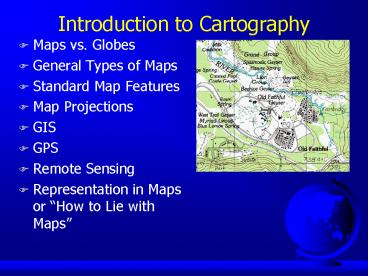Introduction to Cartography - PowerPoint PPT Presentation
1 / 46
Title:
Introduction to Cartography
Description:
Introduction to Cartography Maps vs. Globes General Types of Maps Standard Map Features Map Projections GIS GPS Remote Sensing Representation in Maps or How to Lie ... – PowerPoint PPT presentation
Number of Views:4112
Avg rating:3.0/5.0
Title: Introduction to Cartography
1
Introduction to Cartography
- Maps vs. Globes
- General Types of Maps
- Standard Map Features
- Map Projections
- GIS
- GPS
- Remote Sensing
- Representation in Maps or How to Lie with Maps
2
Maps versus Globes
- Map a representation of the world or part of it,
in two dimensions - Globe a 3-D representation of the entire earth
surface. - What are some advantages and disadvantages of
each?
3
Introduction to Cartography
- Maps vs. Globes
- General Types of Maps
- Standard Map Features
- Map Projections
- Representation in Maps or How to Lie with Maps
4
General Types of Maps
- Thematic
- These maps represent the spatial dimensions of
particular phenomenon (themes).
- General Purpose and Topographic
- Depict the form and relief of the surface and/or
general features, such as roads, buildings, and
political boundaries.
5
Thematic Maps
- These maps represent the spatial dimensions of a
particular phenomenon (theme). - Types
- Isopleth maps - isolines connect points of equal
magnitude. - Choropleth map - tonal shadings are graduated to
represent areal variations in number or density
within a region, usually a formal region.
6
Choropleth Maps
7
Isopleth Maps
8
Isopleth Maps
9
Map Projections
- Mathematical method for systematically
transforming a 3-D earth into a 2-D map. - Three traditional types
- cyllindrical
- conical
- planar (azimuthal-zenithal)
- Newer Mathematical Projections
- Robinson
10
Cartographers Dilemma
- All maps introduce distortion
- shape (conformance)
- size (equivalence)
- direction
- distance
- Maps can be either equivalent or conformal, but
cannot emphasize both characteristics.
11
(No Transcript)
12
(No Transcript)
13
(No Transcript)
14
(No Transcript)
15
Robinson Projection- neither equivalent nor
conformal
16
Gall-Peters Projection- Equivalent (Equal Area)
Map Projection
17
Introduction to Cartography
- Maps vs. Globes
- General Types of Maps
- Standard Map Features
- Map Projections
- Representation in Maps or How to Lie with Maps
18
Map Scalerelates distance on map to distance on
earth, thus smaller scale represents larger area.
- Small Scale
- shows large area
- 110,000,000 would represent about 1/2 of U.S. on
single page of paper.
- Large Scale
- shows small area
- 163,360 would represent a small town on a single
page of paper.
What is the largest scale map possible?
19
- Which end of the spectrum is most accurate?
- Which end requires more generalization?
- Which end shows the largest amount of land?
20
Map Scale - 3 Types
21
Orientation or Direction
- North arrow or Compass Rose
- European maps of the dark ages, prior to European
acceptance (1500s) of the magnetic compass, were
oriented to the east. After compass it made
more sense to place north at the top during use.
N
22
Grid North very close to true north. Used to
place grids on maps for archaeology, mines,
artillery targeting.
23
The Mercator Projection, 1569
24
Mercators Navigation Technique Gnomonic
Projection shows great circles as straight
line. Mercator Projection shows constant compass
headings (azimuth) as straight lines.
Rhumb Lines
25
What is GIS?
- Stands for "geographic information systems"
- Definition a system for the input, storage,
manipulation, and output of geographic data - a specialized "information system
- information systems are used to work with
(manipulate, summarize, query, edit, visualize)
information stored in computer databases - utilizes spatial indexing of information to track
what is where on the Earth's surface
26
Elements of a Geographic Information System (GIS)
- Database with spatially-coded data
(latitude/longitude) - Computer
- GIS Application Software (ArcView, ArcInfo,
MapInfo) - Video Map Display
- Scanners
- Digitizer
- Plotter/Printer
27
(No Transcript)
28
Functions of a Geographic Information System
- Site selection
- Find density within an area
- Catalogue and track spatial data
- Land use maps, for example
- Network Functions
- Street grid navigation
- Municipal water supplies, sewers
- Hydrology (rivers, streams, lakes)
- Consumer Tracking and Marketing
29
Natural Resource GIS
30
High Quality Map Display
31
Examples of Geographic Information Systemsand
Remote Sensing
- Google Earth
- Zillow.com
- National Atlas of the United States
32
GPS
33
(No Transcript)
34
(No Transcript)
35
GPS and GIS are increasingly integrated.
36
- Photographic Remote Sensing
- aerial photos - camera mounted on airplane takes
visible light photographs - infrared film - sensitive to red end of the light
spectrum (crops and plants)
37
Remote Sensing
- Digital Remote Sensing
- Multispectral Sensors
- visible, radar, infrared, ultraviolet
- Digital Image Manipulation
- Direct download into GIS systems
38
Interpreting Aerial Photos and Remotely-Sensed
Images
- Image Tone/Color/Reflectivity colors and
reflected UV and Infrared give clues to landscape
elements. For example, infrared film (or sensors)
return shades of pink and red for healthy
vegetation. - Texture the coarseness or smoothness of a
surface can help in identification - Pattern human systems and some physical systems
have clear patterns - Shadows provides clues to the height and size
of objects
39
Landscape change over time
40
Iguazu Falls, Argentina / Paraguay LandSat
Images 1973-2004
41
How to Lie with Maps
- Misrepresentation - Propaganda Maps
- Selection or Omission of Map Features
- Scale
- Orientation
- The Authoritative Power of Maps
42
Propaganda Maps
Japanese Map from 1905 before the Russo-Japanese
War.
43
Propaganda Maps
Map captured from CNN.com on February 2, 2003
one month before the invasion of Iraq.
44
(No Transcript)
45
Whats misrepresented in this map?
46
(No Transcript)































